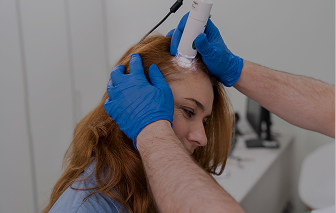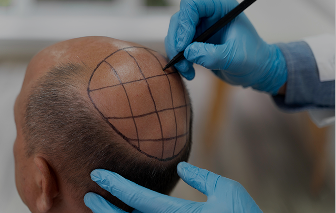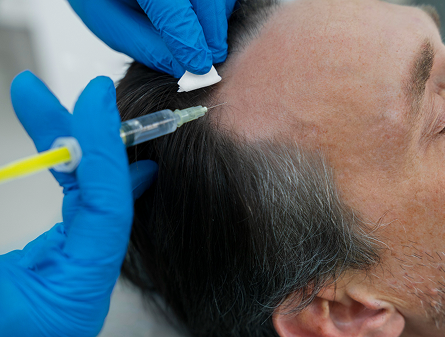Low-level laser therapy (LLLT) exposes the skin tissue to wavelengths of light in the “near-infrared” and red side of the visible light spectrum. By stimulating the stem cells in the scalp it can cause hair to grow. A hair transplant is a surgical procedure where healthy hair grafts are extracted from a scalp donor area and then implanted into balding or thinning areas.
Once implanted, the hairs will begin to produce hair naturally after 3 to 4 months with continuous growth in line with the rest of your hair. LLLT is a non-invasive treatment option that can be performed in a clinic or at home.
A hair transplant is a procedure that will require significant planning and aftercare but is typically a once-off treatment. Check out the comparison table below to see the main differences between a hair transplant and LLLT.
- Laser therapy uses low-level light to stimulate scalp circulation and follicle metabolism.
- Unlike a hair transplant, it is non-invasive and suitable for early to moderate hair thinning.
- Hair transplants involve relocating hair follicles from a donor site to thinning or bald areas.
- This surgical procedure is intended for more advanced hair loss than laser therapy.
- At-home laser caps range from $300 to $1000 and require no ongoing product purchases.
- Laser therapy is cheaper long-term than a transplant, though with subtler results.
- Australian hair transplants generally cost $5,000–$15,000 per session.
- As opposed to laser therapy, it is a single but expensive investment with instant coverage.
- Laser therapy requires ongoing sessions 3–5 times weekly.
- Results take 3–6 months to appear and continue with consistent use.
- Hair transplants are completed in 1–2 sessions, with visible growth over 6–12 months.
- Compared to laser therapy, results are permanent after recovery.
- Laser treatment is done using red light on the scalp to stimulate follicles.
- Laser therapy is done externally without damaging the skin.
- Hair transplants place individual follicles surgically using FUT or FUE methods.
- As compared to laser treatment, it takes time for anaesthesia and recuperation.
- Laser therapy is safe with few side effects, making it ideal for sensitive users.
- No downtime or physical trauma involved.
- Hair transplants carry surgical risks like infection, scarring, or swelling.
- Unlike laser therapy, post-op care is required to ensure healing.
- Laser devices can be used at home with minimal setup, especially hands-free caps.
- Simpler than surgery and more manageable for daily routines.
- Hair transplants are a single-event procedure but require clinic visits and healing.
- Unlike laser therapy, it involves preparation, anaesthesia, and follow-ups.
- Laser therapy is available online and does not require medical consultation.
- More accessible than a transplant for those in remote areas.
- Licensed surgeons perform hair transplants in clinical settings.
- Compared to laser therapy, access is limited by cost, travel, and wait times.
- Laser therapy offers ongoing improvement with consistent use.
- Results fade gradually if treatment is paused.
- Hair transplants are permanent once follicles have taken hold.
- Unlike laser therapy, they don’t require ongoing sessions to retain regrowth.
- Laser therapy pairs well with minoxidil or oral supplements.
- Often used post-transplant to support healing and optimise results.
- Hair transplants can be complemented with laser therapy or medications to boost density.
- Compared to laser therapy, they are often the final step in a bro
- Laser therapy appeals to users seeking a non-invasive, gradual solution.
- Viewed as high-tech and low-risk.
- Hair transplants appeal to those desiring a dramatic, lasting transformation.
- Unlike laser therapy, they offer instant visual improvement post-recovery.
- Laser therapy supports scalp circulation and follicle repair without affecting surrounding tissues.
- Best for early-stage loss and maintaining existing hair.
- Hair transplants restore hair where growth is no longer possible naturally.
- Compared to laser therapy, they offer structural coverage, not just support.
- Laser devices are long-lasting and reusable, generating minimal waste.
- More sustainable over time than surgical alternatives.
- Hair transplants involve clinical waste such as medical tools, bandages, and disposable items.
- Less eco-friendly than laser therapy due to the procedural nature.
Shop our hair solutions
We are committed to providing affordable hair regeneration services for people all over Australia. Our formula can help you regain your confidence.
Shop Now

Comparison Summary
A hair transplant is a long-term, though not permanent, treatment option. It may be suitable for you if you do not want to have to maintain regular treatment sessions like with LLLT. When looking at laser therapy vs transplant costs, a hair transplant is also a considerable investment.
It could be more cost-effective in the long run compared to LLLT if you are seeking treatments in a clinic. LLLT devices can be a cheaper alternative but will generally not be as effective as clinical-grade equipment and will require more frequent use. LLLT results are reversible if the sessions are not kept up.
A hair transplant provides continuous and natural growth but the surrounding areas of the recipient site will continue to experience hair loss. A hair transplant then is more suitable if your hair loss has stabilised to prevent the need for additional supplementary treatments or further hair transplants.
A hair transplant carries risks as it is a surgical procedure. Comparatively, LLLT does not have many reported side effects and long-term use has not shown to have negative issues yet.
User Guidance
A hair transplant is a significant time investment in terms of planning beforehand and the aftercare procedures required for positive results. Comparatively, LLLT is less of a time commitment and is non-invasive meaning it shouldn’t cause too much disruption to your daily routine.
LLLT may also be more accessible since at-home devices can be purchased. A hair transplant may require long-distance travel depending on where you live and time off from work for recovery.
LLLT is a good option if you are looking for a convenient treatment that can be performed at home and that does not typically come with negative side effects. A hair transplant is a good choice if you want long-lasting results and to increase regrowth effectiveness after a single treatment that does not usually require much upkeep.
Take Our Hair Loss Quiz to See Which Treatment Suits You?
Take A Hair Quiz

Frequently Asked Questions
We have put some commonly asked questions.
Nunc scelerisque tincidunt elit. Vestibulum non mi ipsum. Cras pretium suscipit tellus sit amet aliquet. Vestibulum maximus lacinia massa nontor.
Platelet-rich plasma (PRP) treatment involves drawing blood from the patient, isolating the beneficial nutrients and injecting it into the scalp where hair loss is occurring. This promotes hair growth and has many other applications from encouraging healing to skin rejuvenation.
Platelet-rich plasma (PRP) treatment involves drawing blood from the patient, isolating the beneficial nutrients and injecting it into the scalp where hair loss is occurring. This promotes hair growth and has many other applications from encouraging healing to skin rejuvenation.
Platelet-rich plasma (PRP) treatment involves drawing blood from the patient, isolating the beneficial nutrients and injecting it into the scalp where hair loss is occurring. This promotes hair growth and has many other applications from encouraging healing to skin rejuvenation.







 See All
See All